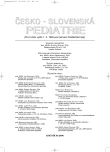-
Medical journals
- Career
Certain Aspects of Family Environment of Czech Children. Results of the ELSPAC Study
Authors: L. Kukla 1; D. Hrubá 2; M. Tyrlík 3
Authors‘ workplace: Masarykova univerzita, Lékařská fakulta, Ústav sociálního lékařství a veřejného zdravotnictví ; oddělení preventivní a sociální pediatrie, Brno vedoucí prof. MUDr. J. Holčík, DrSc. 1; Masarykova univerzita, Lékařská fakulta, Ústav preventivního lékařství, Brno vedoucí prof. MUDr. Z. Brázdová, DrSc. 2; Masarykova univerzita, Filozofická fakulta, Psychologický ústav, Brno vedoucí prof. PhDr. M. Svoboda, CSc. 3
Published in: Čes-slov Pediat 2006; 61 (6): 357-364.
Category: Original Papers
Overview
The most natural way of adopting healthy life style is to absorb it within family. This partial work contains characteristics of selected aspects of family environment with special focus on smoking influencing children within the period between 18 months and 5 years of age, obtained from ELSPAC study. The goal is to draw the paediatricians‘ attention to a significant number of children exposed to passive smoking in pre-school age and to invite them to actively approach child protection against the consequences of risk behavior of their parents.
The data about children from the study cohort of ELSPAC study were obtained from mothers and paediatricians in charge: there were 3400 three-year - and 4983 five-year-old children. The data were compared for children of non-smoking mothers and of those with smoking history. Results were statistically processed by SPSS programme.
The most significant for pre-school age children protection from passive smoking exposure in the family proves to be non-smoking behavior of the mother: if she does not smoke, only about 15 to 20 % of children live in smoke environment compared to about 50 to 75 % of exposed children of smoking mothers. Attendance at some preschool facility significantly decreases strong (lasting for several hours or all day) exposure of children to passive smoking. On the contrary, weekends present risk for children in the sense of increased exposure – especially of that strong, lasting all day. Significantly higher necessity of curative medical care of children who are most severely exposed the passive smoking makes their worse health status evident. Almost one fifth of three-year-old and nearly one fourth of five-year-old children have tested alcohol. On the contrary, many fiveyear-old children significantly fall behind in movement skills associated with sports and games: only approximately two thirds of children can ride a bicycle, can throw a small ball or play some board game. Approximately one fourth of children can handle a ball in more skilled way when playing „kindergarten“, throwing it against a wall. Only 4.3 % of children can swim well.
The pre-school age children population is not protected from polluted air by the legislature enforced to protect adult non-smokers. Prevention of child home contact with alcohol offered by parents „to taste“ is impossible.Conclusion:
Pre-school age children in Czech family conditions are exposed to the effects of legal drugs. An important role of paediatricians is to observe exposure to passive smoking, reveal its risks, warn against „tasting“ alcohol and support the development of movement skills of children by focused questions and recommendations, initiate accepting of already existing primary preventive programmes by professional pedagogues in preschool and school facilities.Key words:
exposure to ETS, alcohol, physical skills, children, ELSPAC (Abbreviations: ESLPAC = European Longitudinal Study of Pregnancy and Childhood, ESPAD = The European School Survey Project on Alcohol and Other Drugs)
Labels
Neonatology Paediatrics General practitioner for children and adolescents
Article was published inCzech-Slovak Pediatrics

2006 Issue 6-
All articles in this issue
- Is the Prenatal Origin of Acute Myeloid Leukaemia Common?
- Amanita Phalloides Intoxication – Fully Treatable Event. 25-year’s Experience in Children
- Certain Aspects of Family Environment of Czech Children. Results of the ELSPAC Study
- Possibilities of Endoscopic Techniques in Neurosurgery in Solving Hydrocephalus – First Experience with the Use of Laparoscopy
- Hereditary Fructose Intolerance
- Perspective in the Prevention of Childhood Injuries in the Czech Republic
- Guidelines on the Diagnostics, Treatment and Prevention of Infectious Endocarditis in Children. Working Group of Pediatric Cardiology, Czech Society of Cardiology and Czech Society of Pediatrics
- Czech-Slovak Pediatrics
- Journal archive
- Current issue
- Online only
- About the journal
Most read in this issue- Guidelines on the Diagnostics, Treatment and Prevention of Infectious Endocarditis in Children. Working Group of Pediatric Cardiology, Czech Society of Cardiology and Czech Society of Pediatrics
- Amanita Phalloides Intoxication – Fully Treatable Event. 25-year’s Experience in Children
- Hereditary Fructose Intolerance
- Is the Prenatal Origin of Acute Myeloid Leukaemia Common?
Login#ADS_BOTTOM_SCRIPTS#Forgotten passwordEnter the email address that you registered with. We will send you instructions on how to set a new password.
- Career

